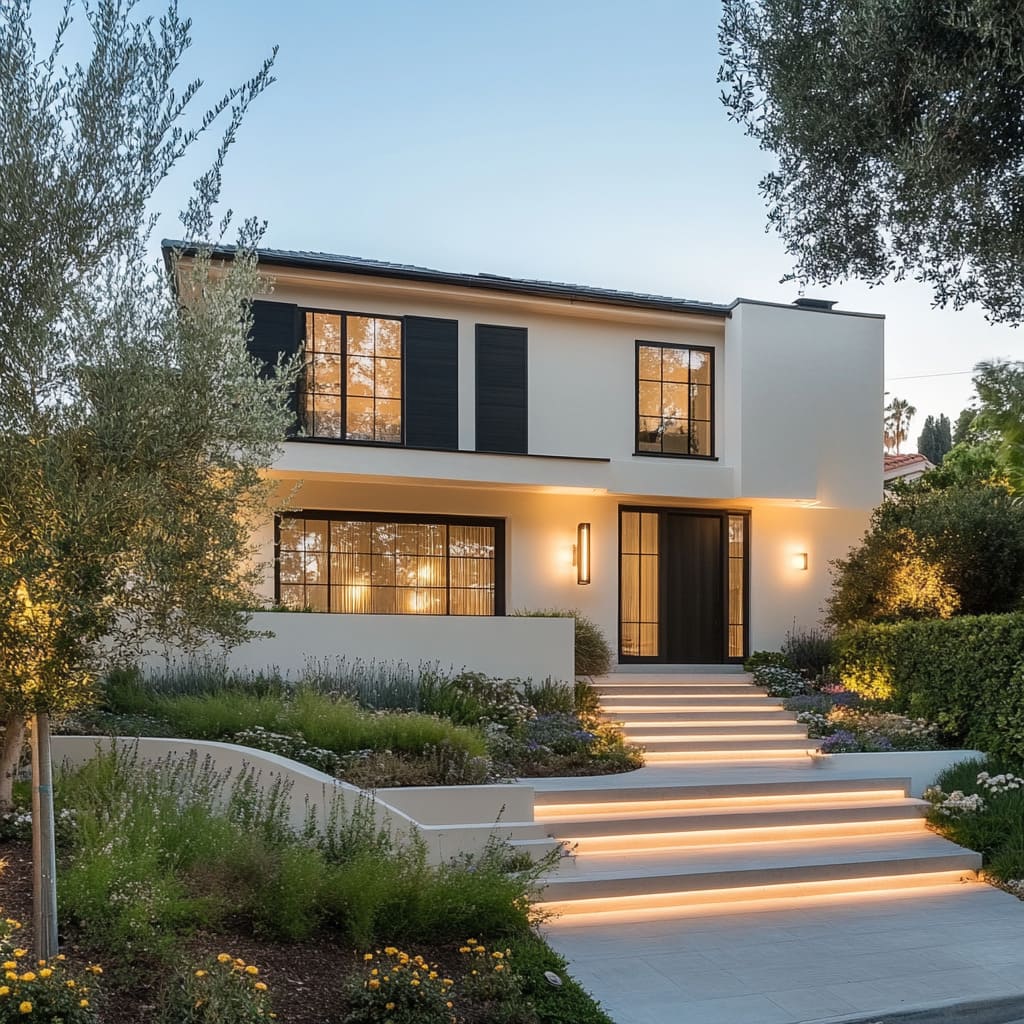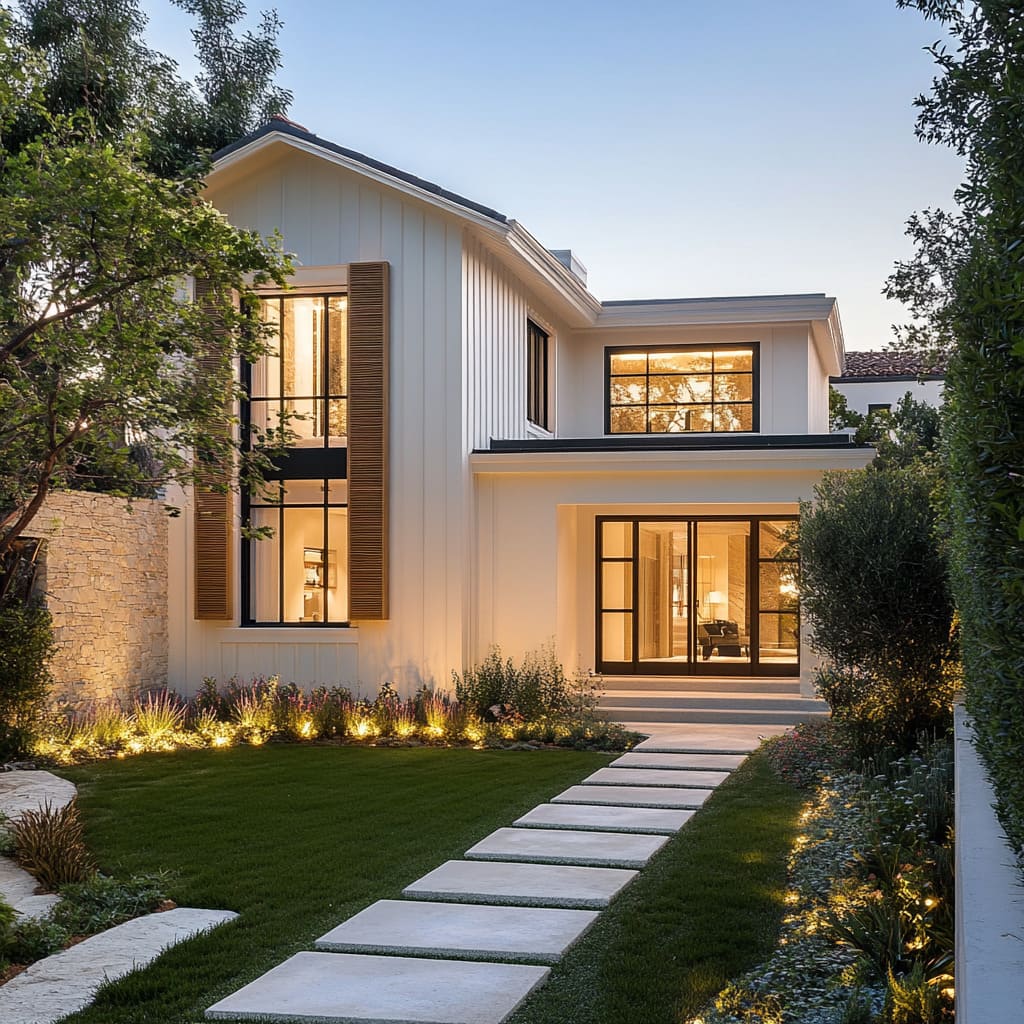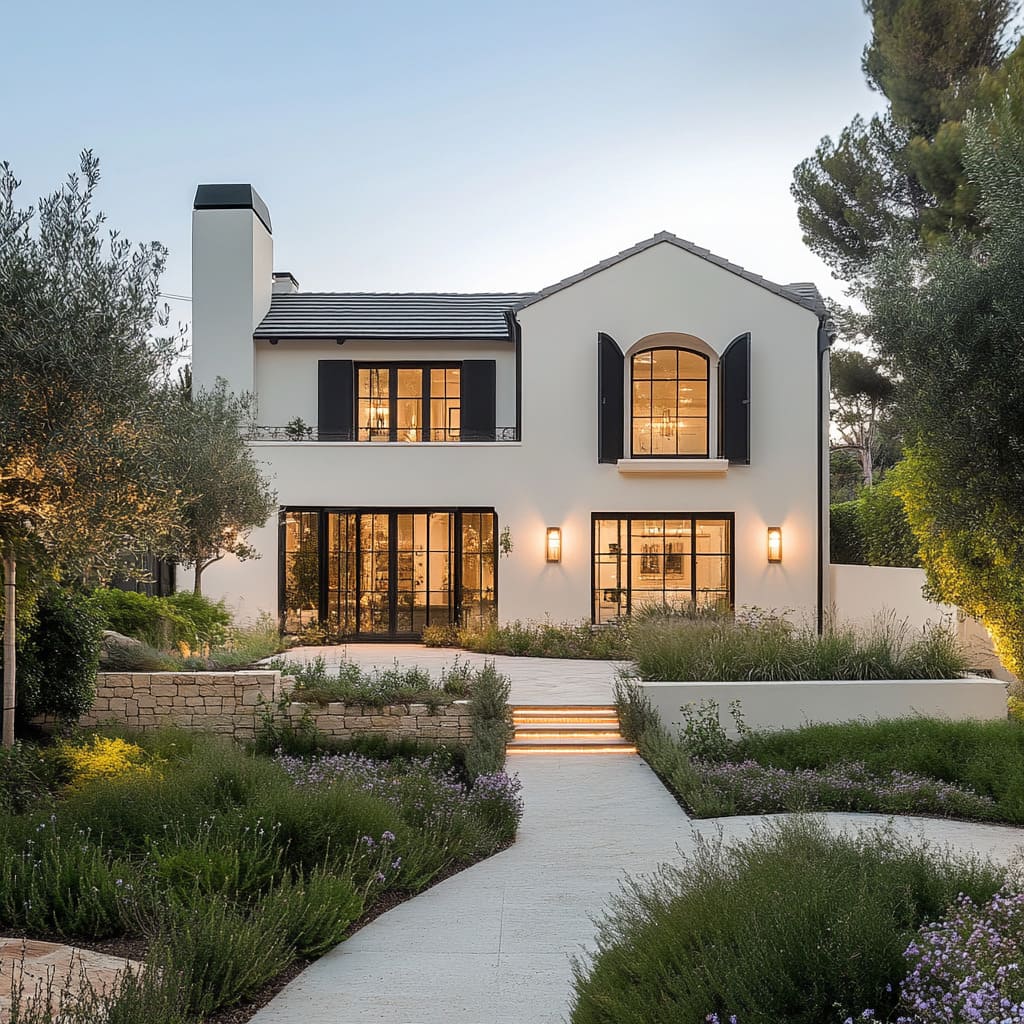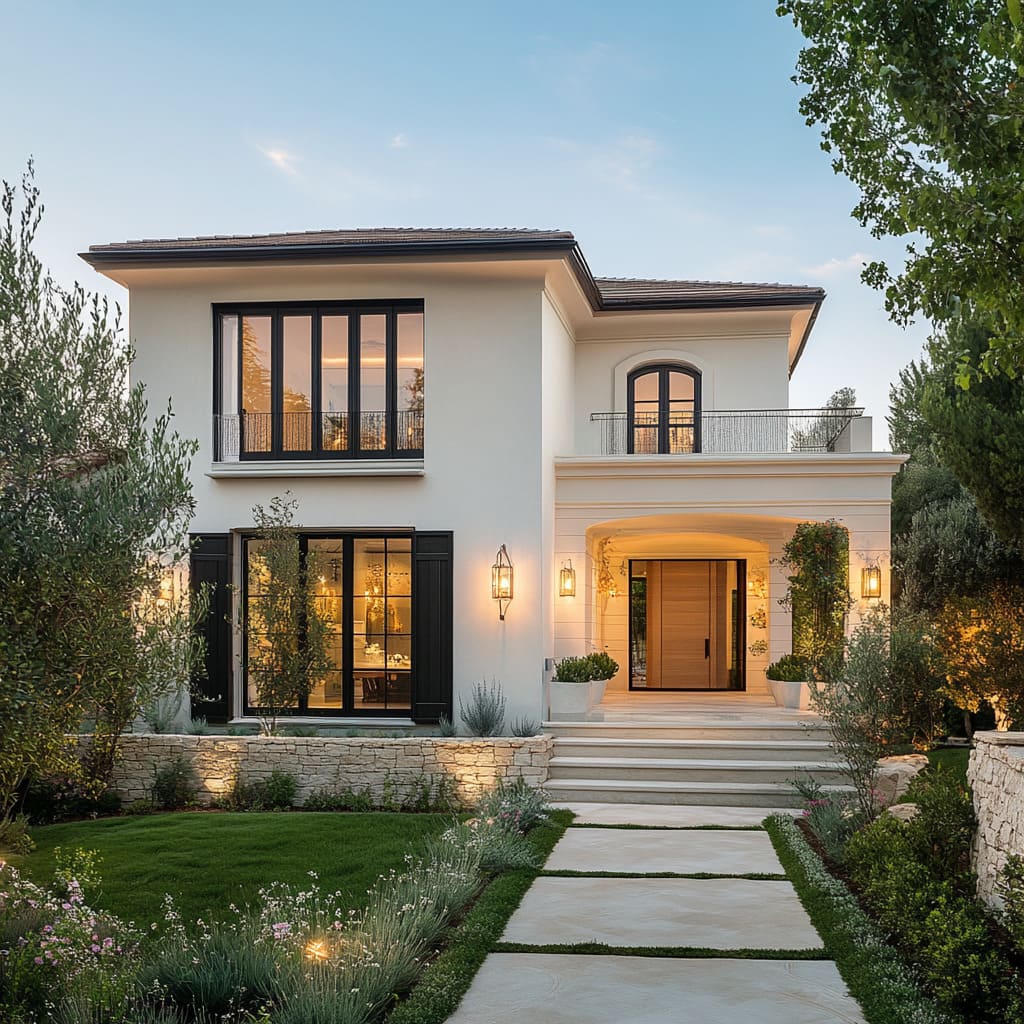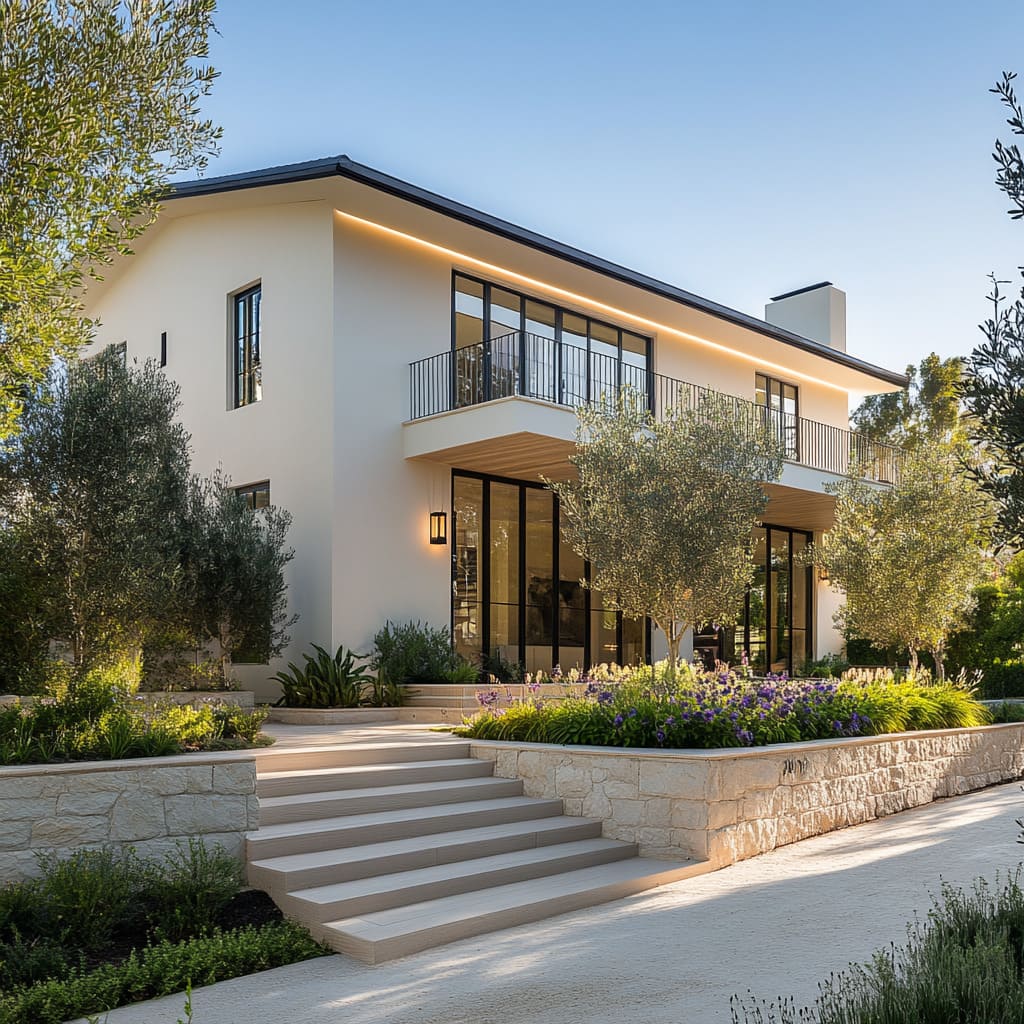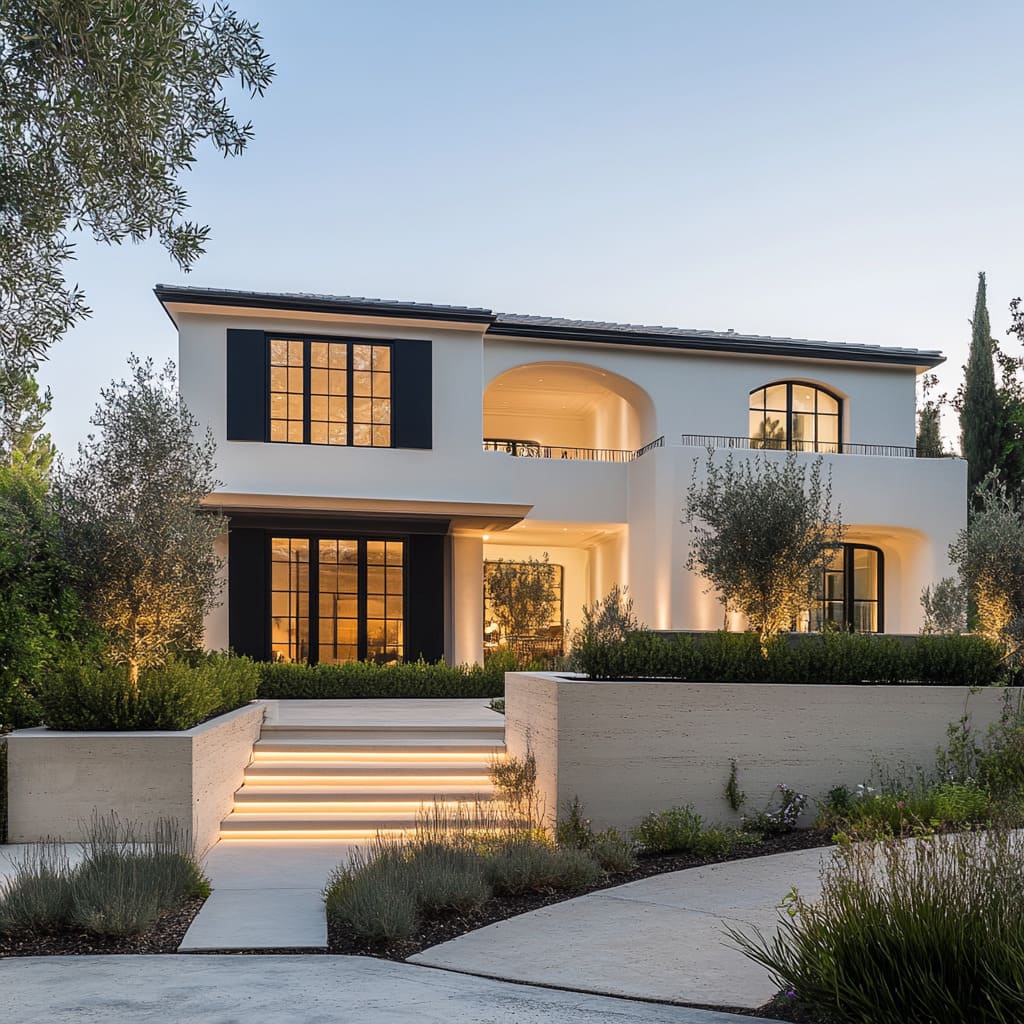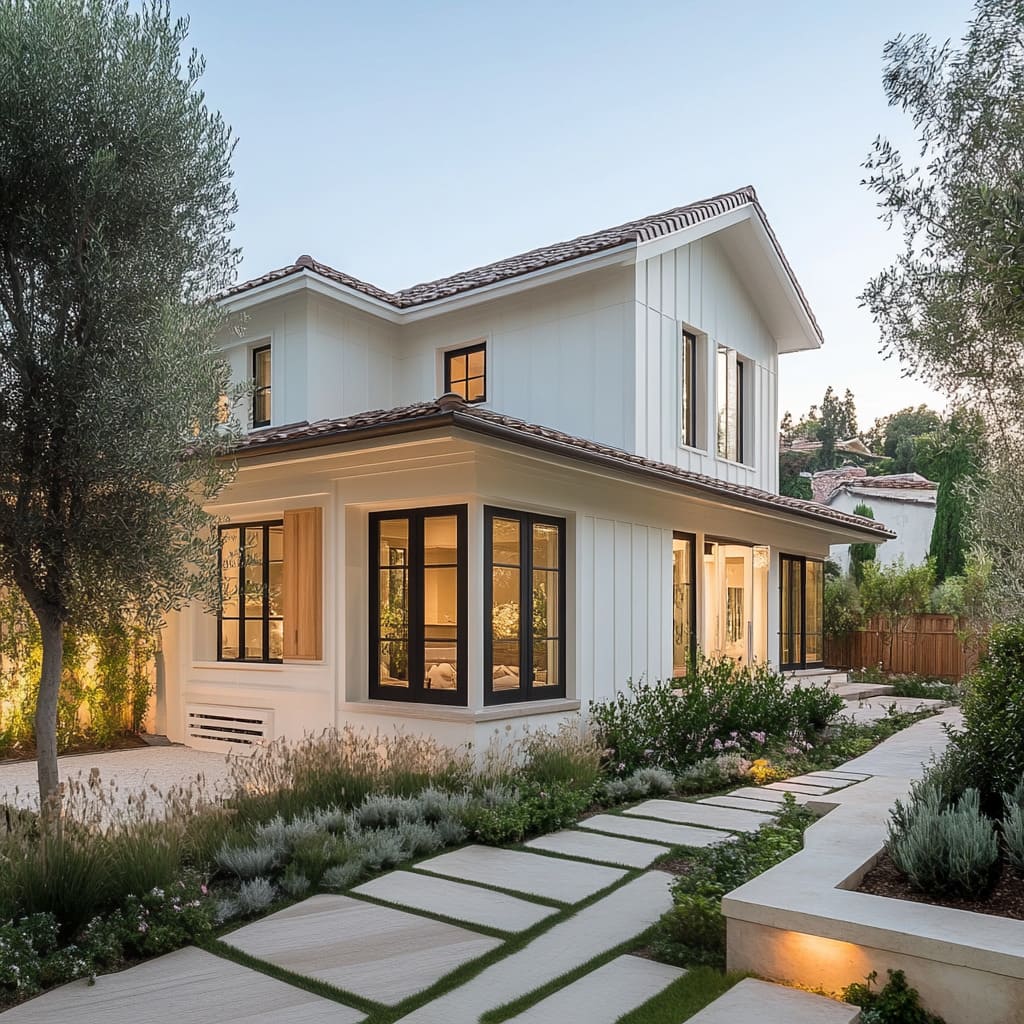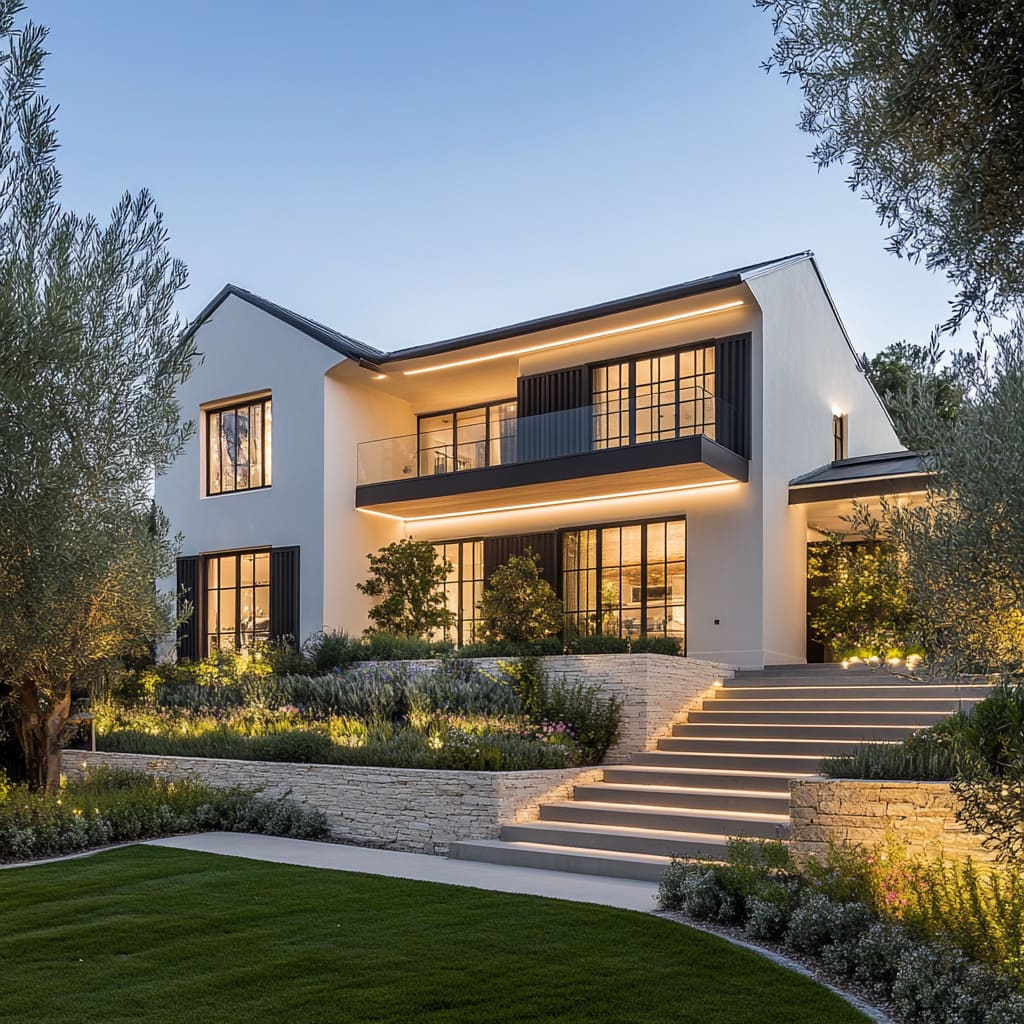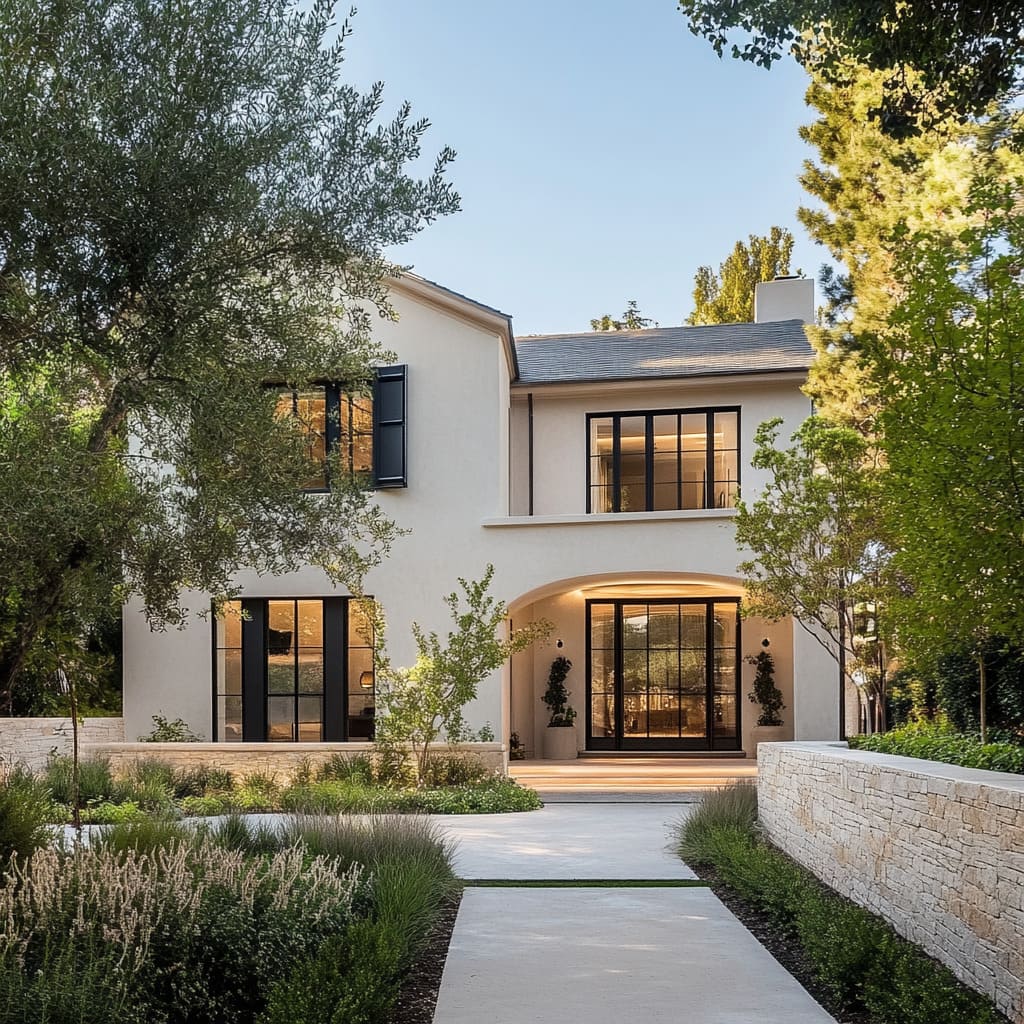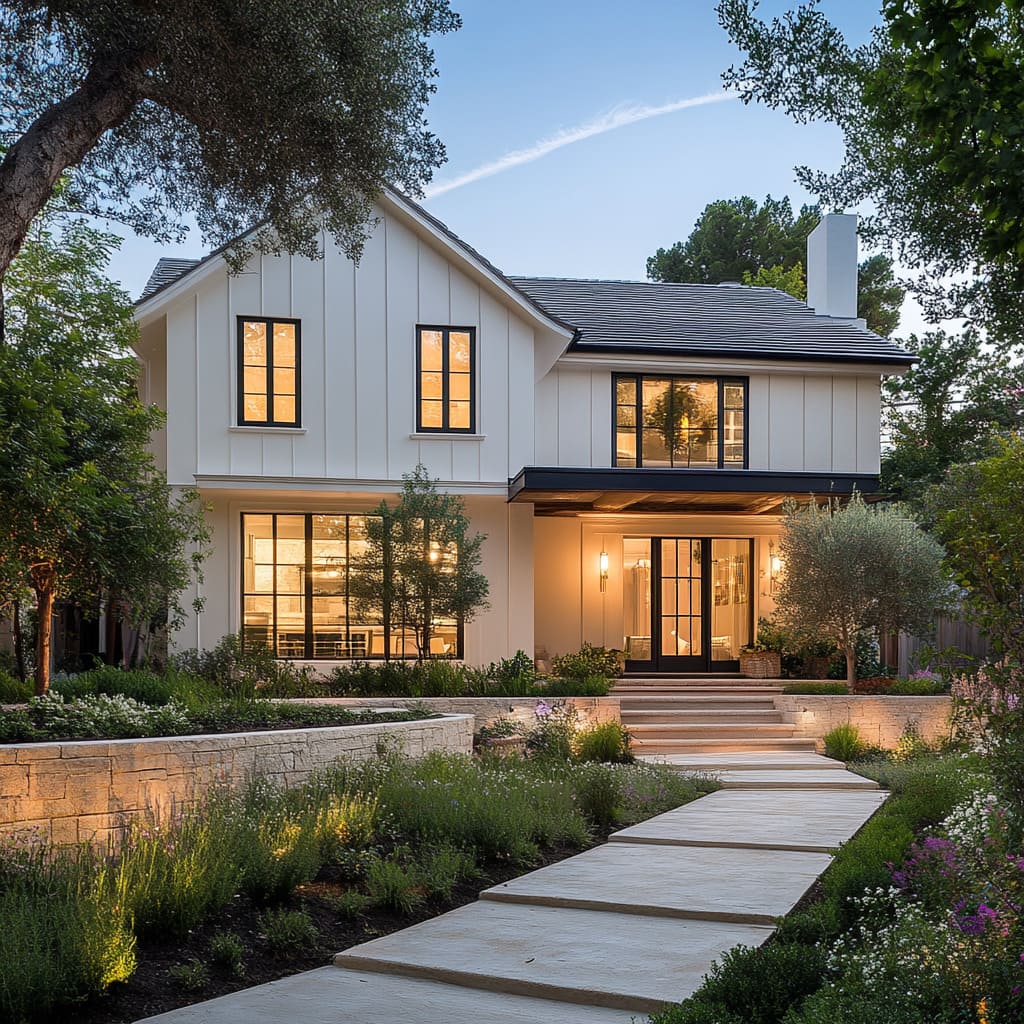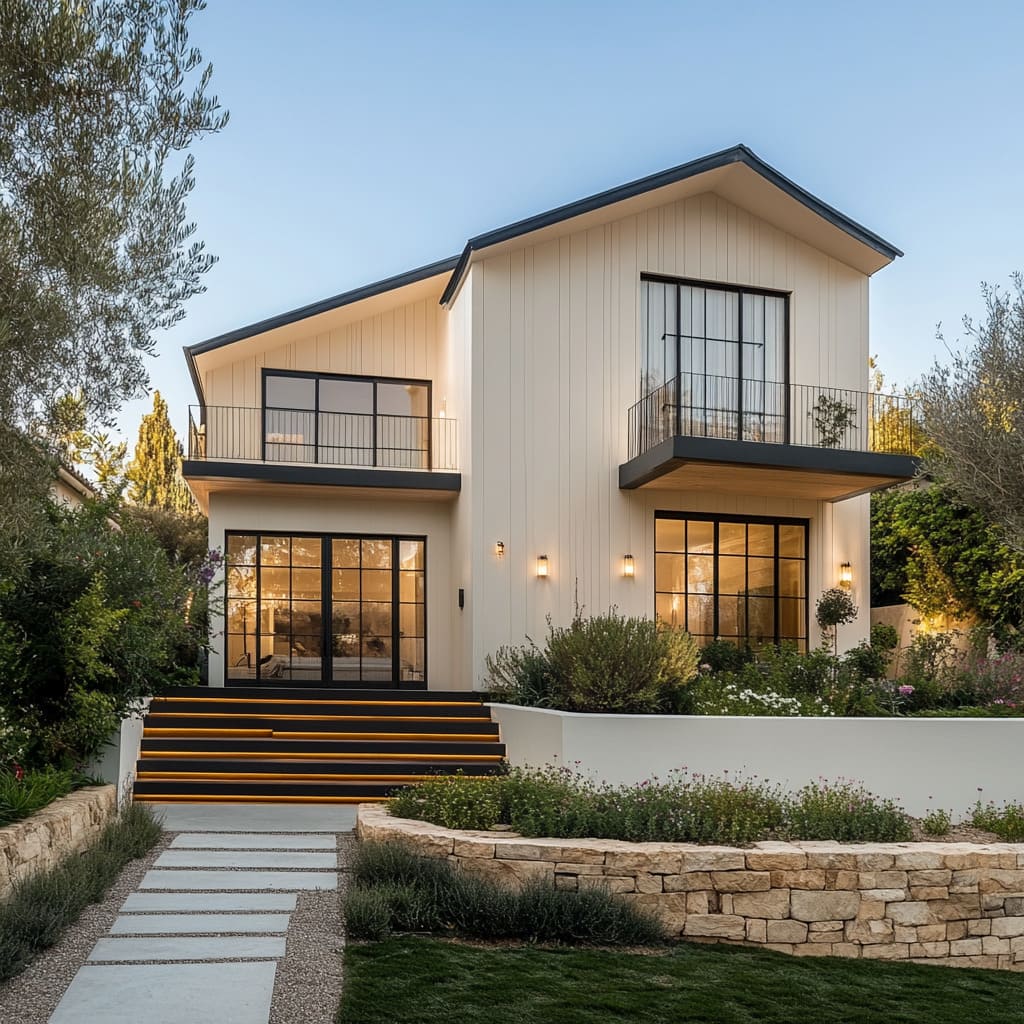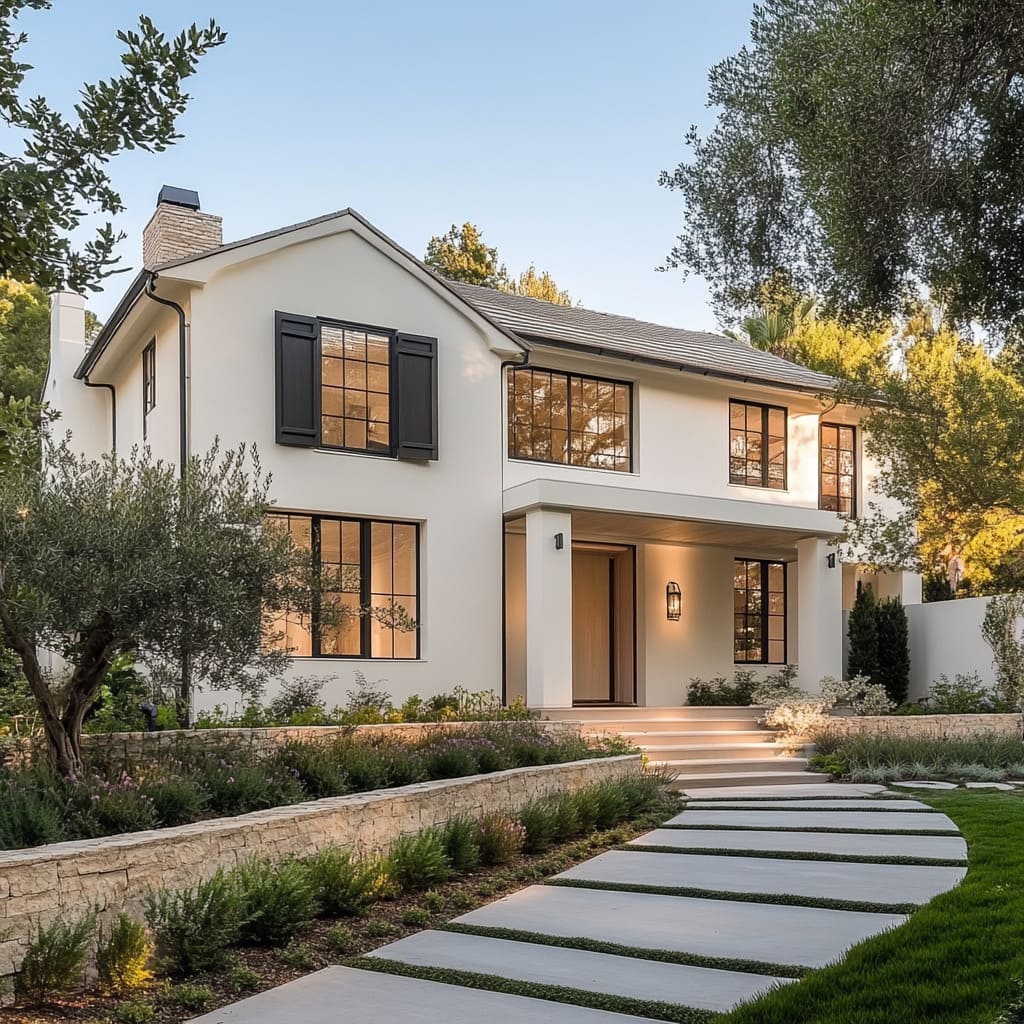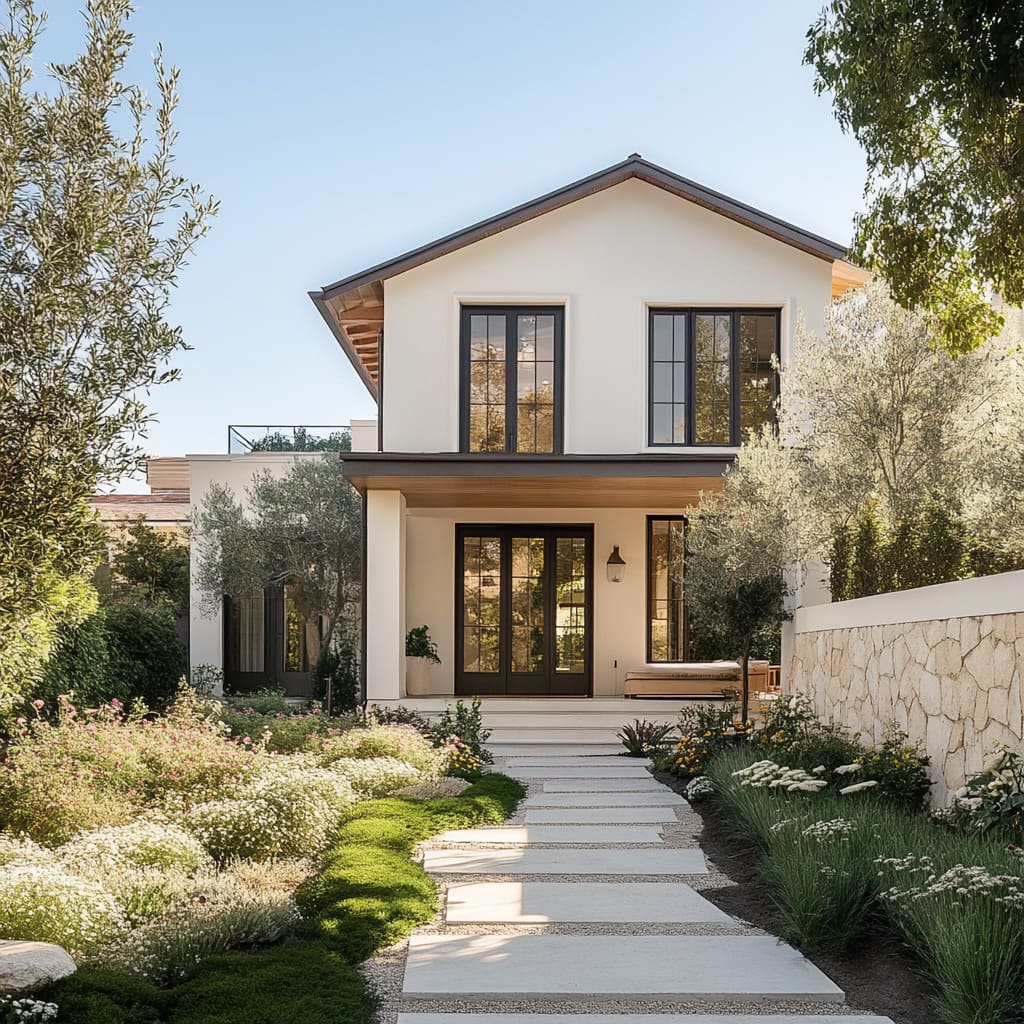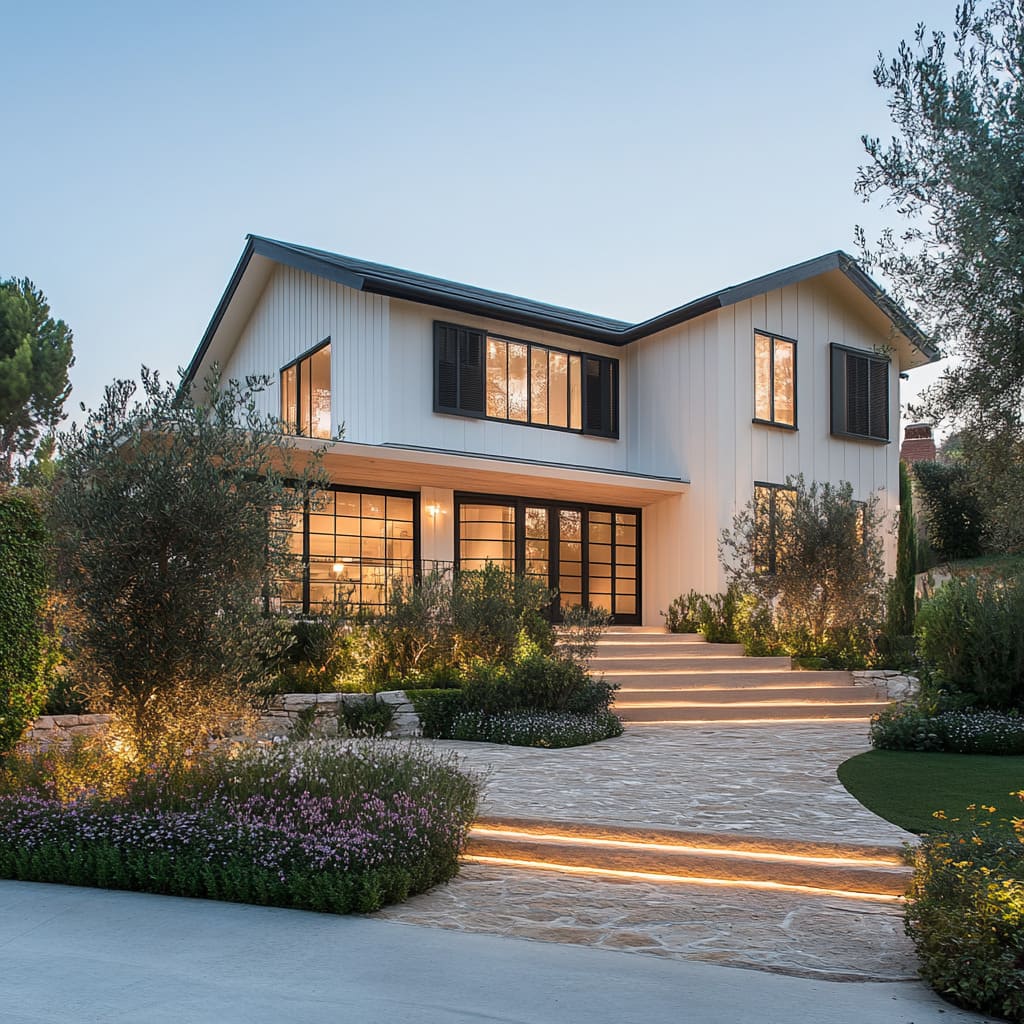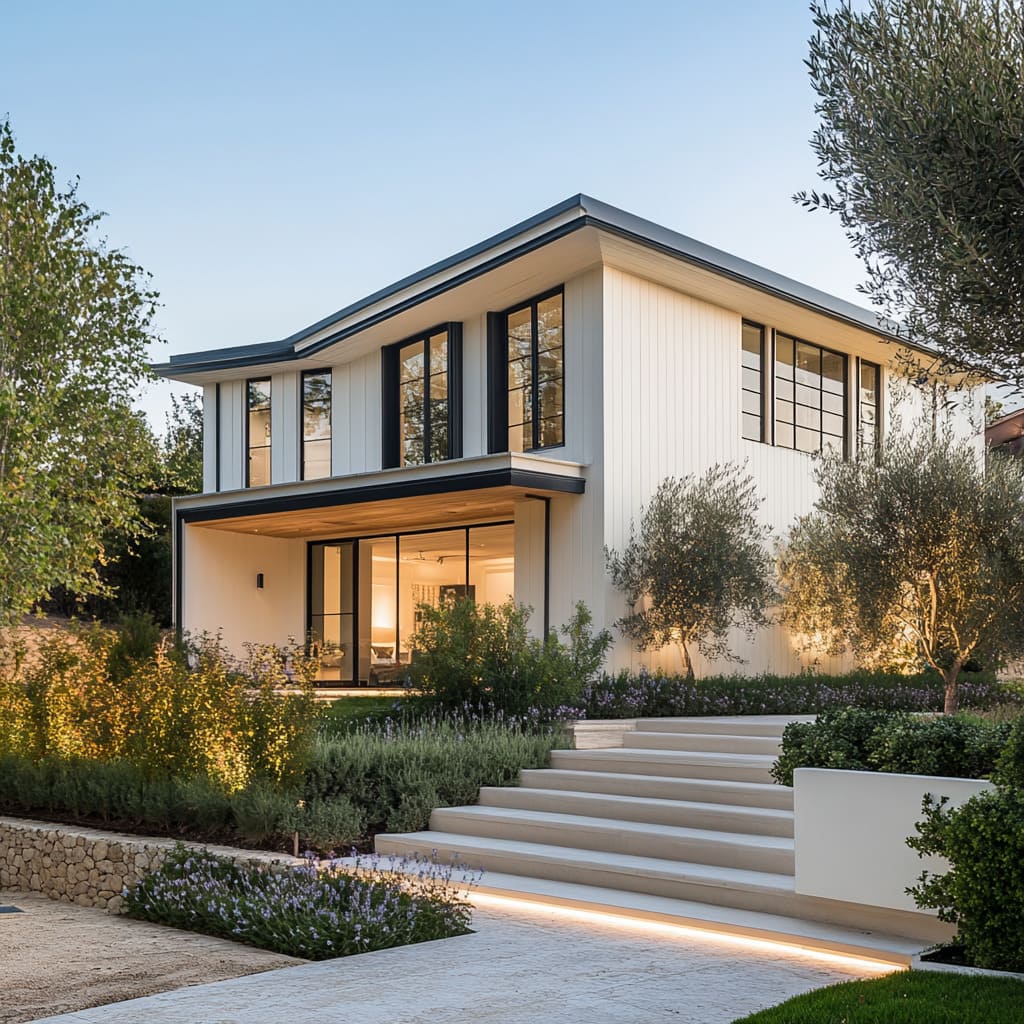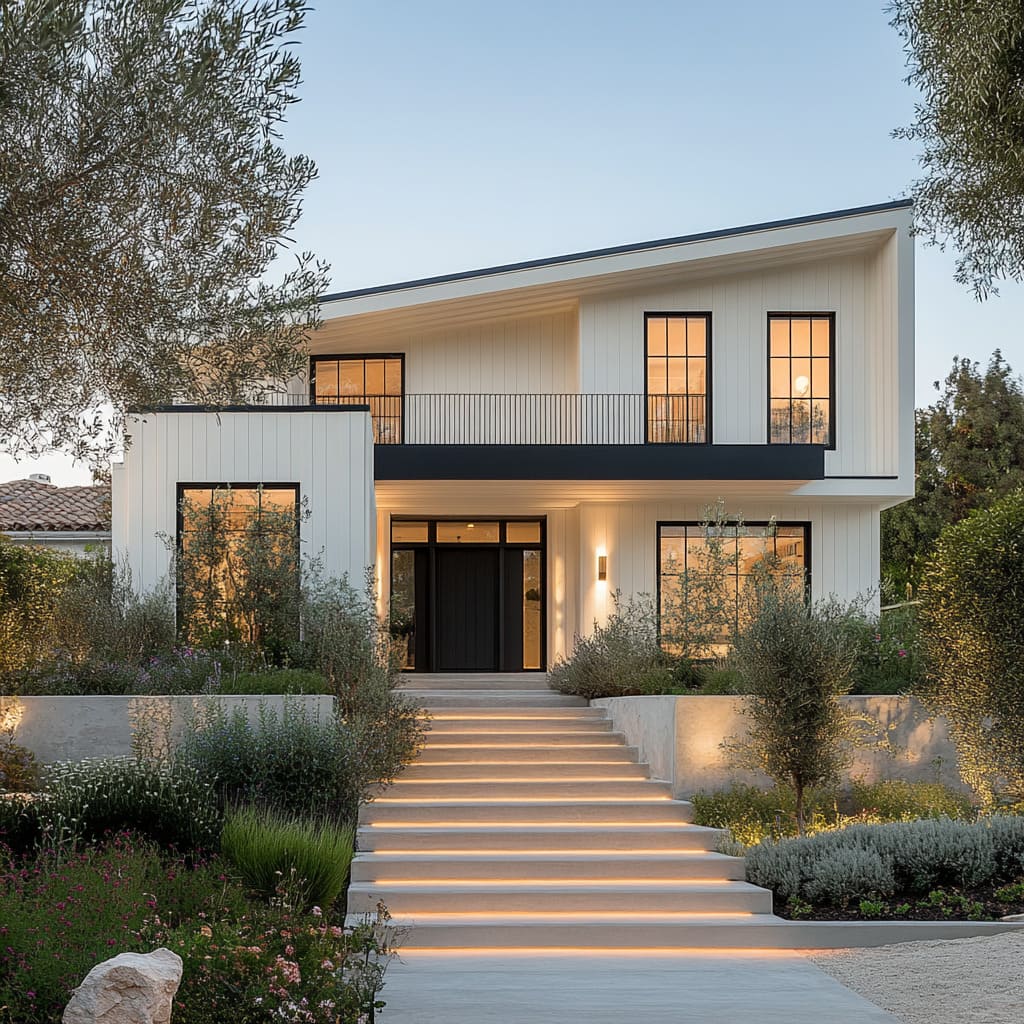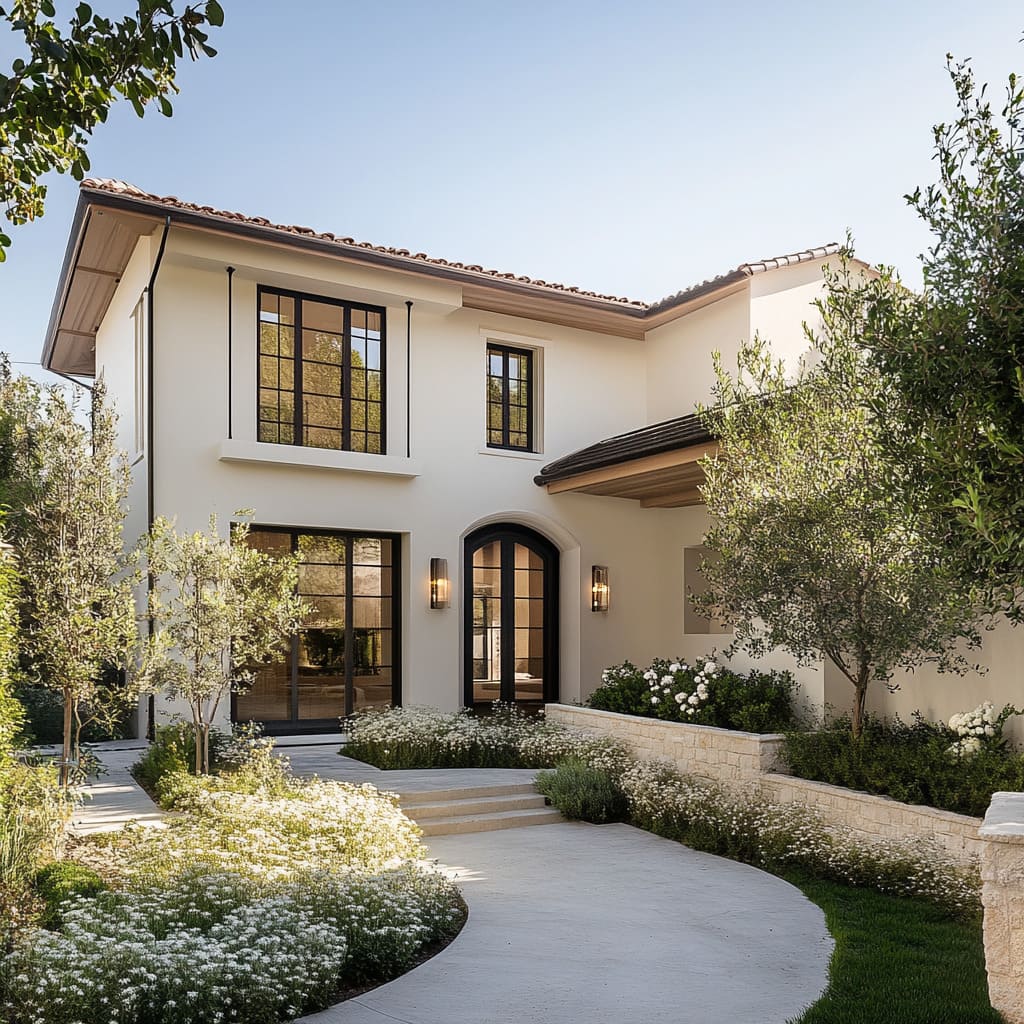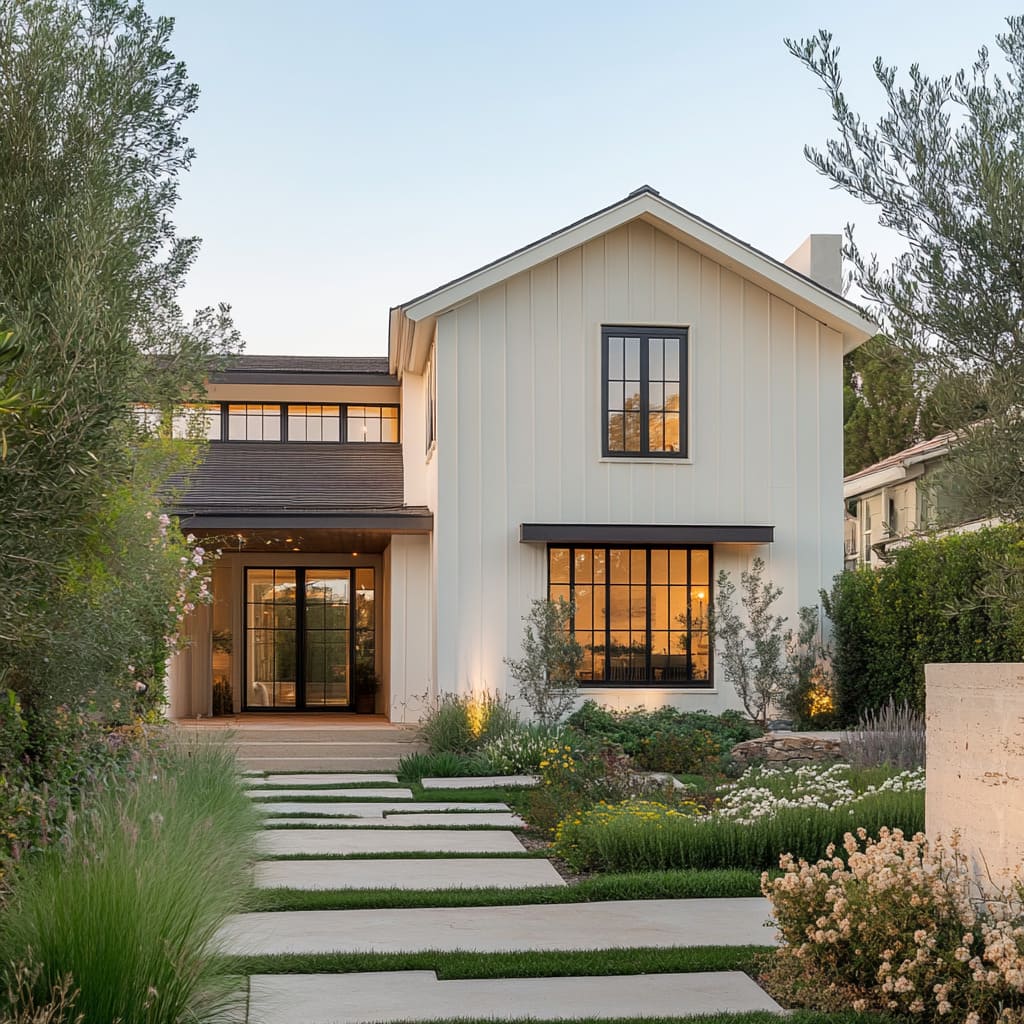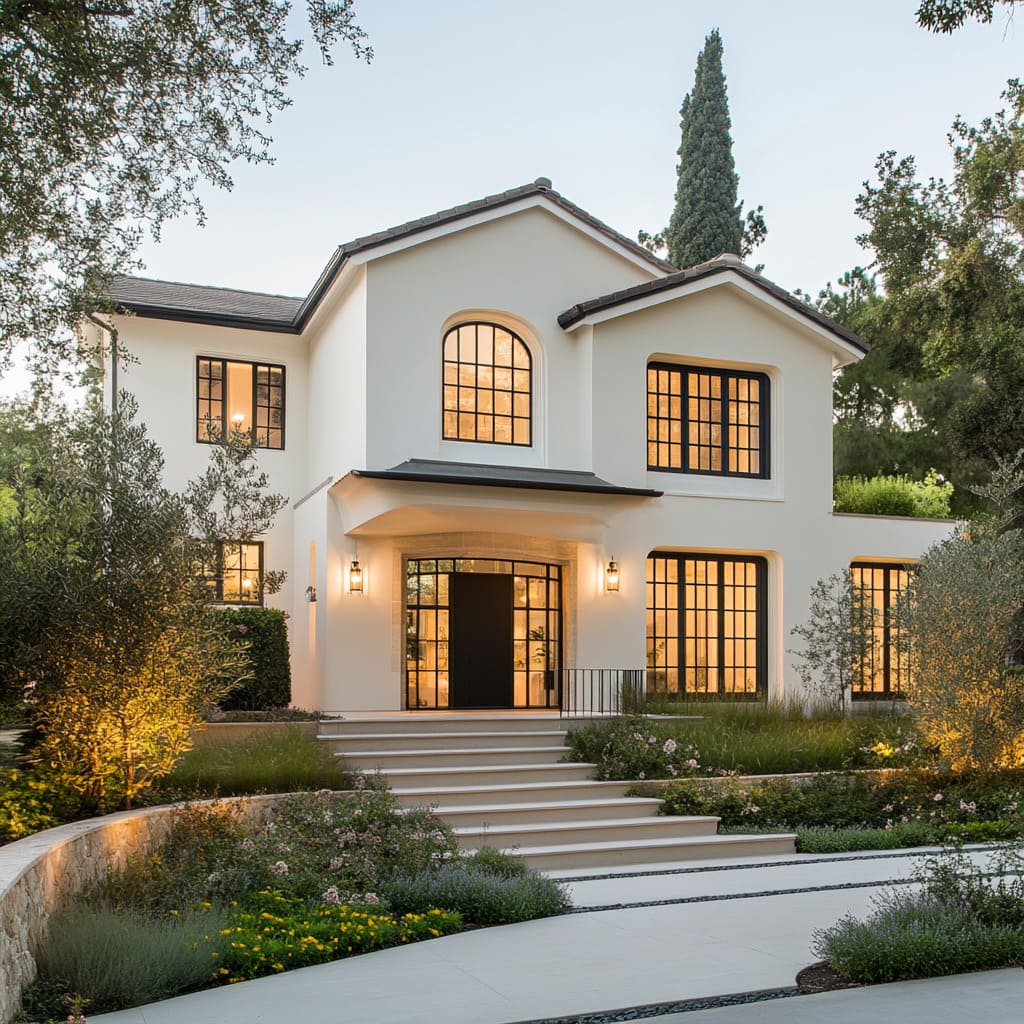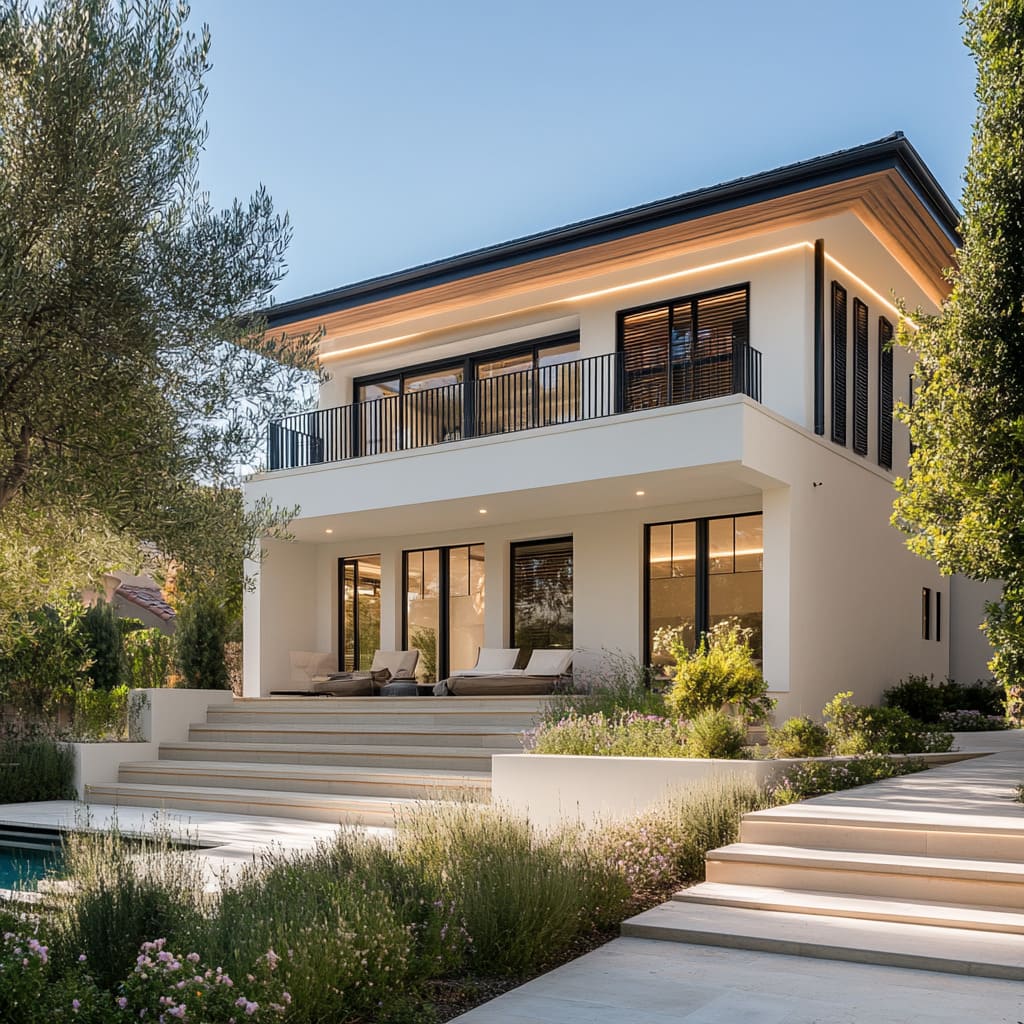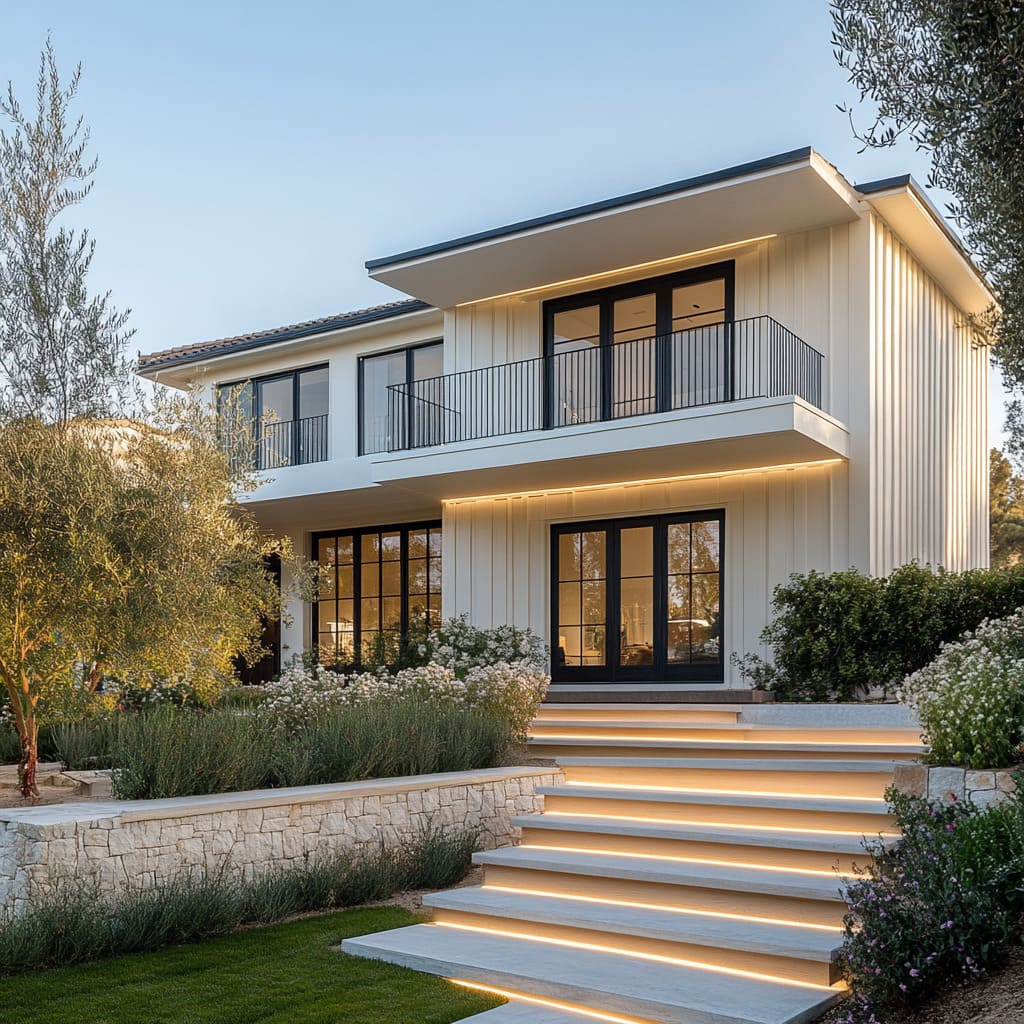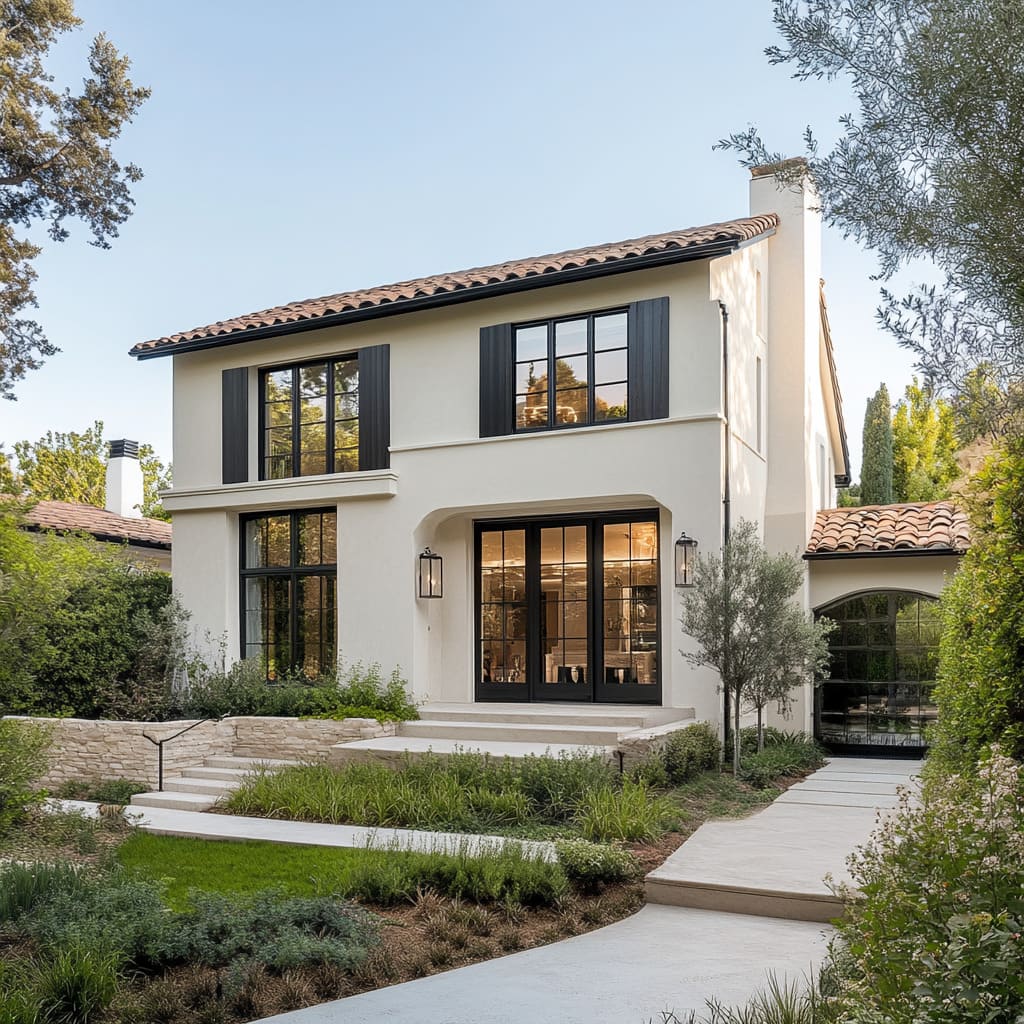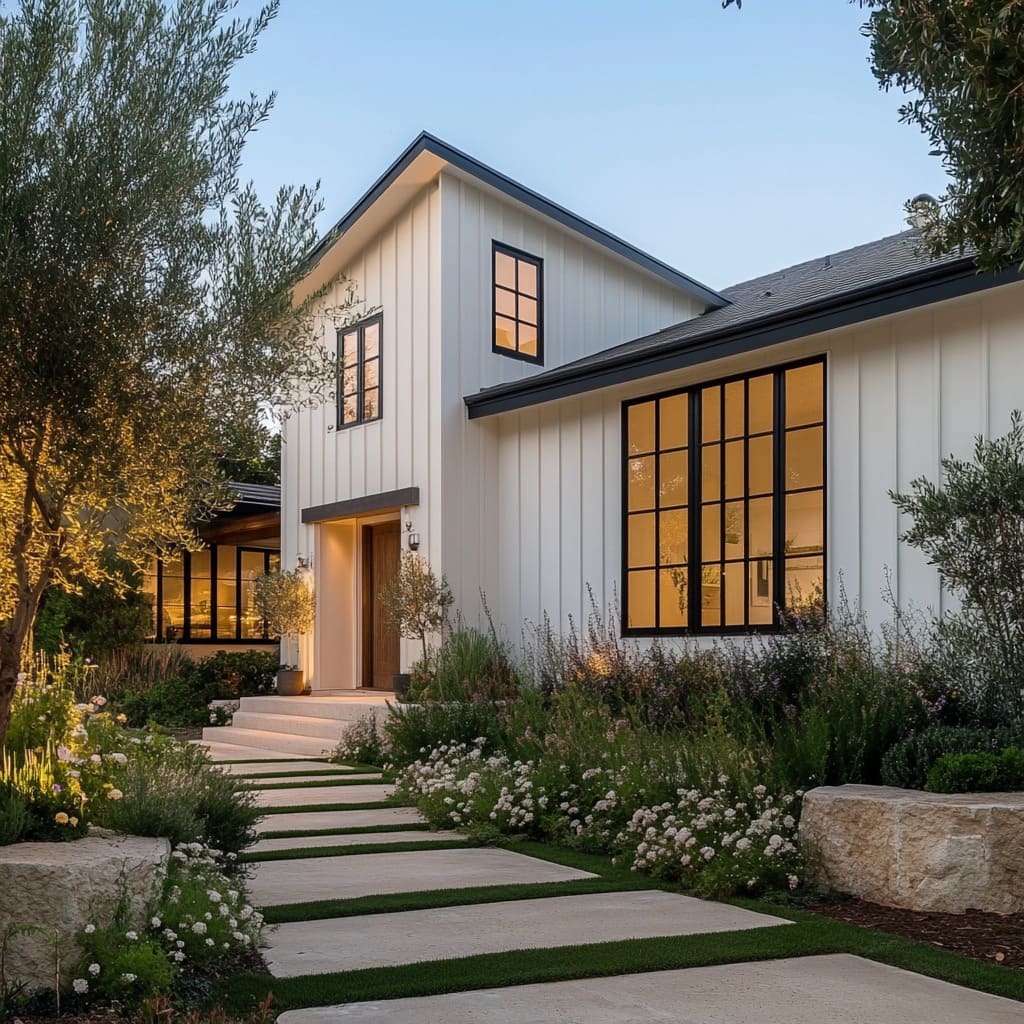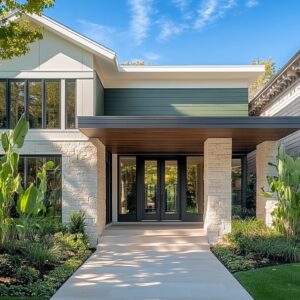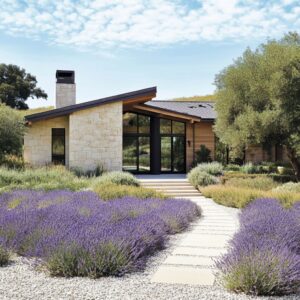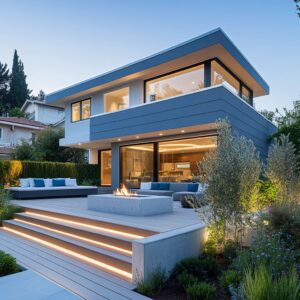Designing a house exterior involves so much more than picking a paint color and calling it a day. From subtle lighting strategies to carefully balanced materials, every detail counts.
Below, we explore 28 key ideas, along with practical tips for each, to help you create a residence that looks thoughtful, modern, and welcoming—all while maintaining a classic sense of structure that never goes out of style.
1. Hidden Rhythms and Proportional Nuances
Many well-designed homes feature proportional alignments that might not be obvious at first glance. This can include roof pitches that echo the angles of walkways, or windows that line up with landscaping features.
- Seek out visual threads. For instance, if your roof is pitched at a certain angle, repeat that angle in walkways or fences.
- Repeating patterns build a sense of harmony and cohesion across the entire property.
2. Minimalist vs. Classical Dialog
Some exteriors cleverly mix sleek, modern lines with historical references—arched windows, shutters, or tile roofs—to create a stylish fusion that feels current but also grounded in tradition.
- If minimalism is your go-to style, warm it up with a single old-world element such as an arch or stone detailing.
- Keep the rest subtle so the classical accent can shine without overpowering the overall look.
3. Texture Layering for Depth
Varying surface textures—like stone, stucco, wood, or board-and-batten siding—can be more influential than using bold colors. The interplay of rough and smooth surfaces adds visual interest in a refined way.
- Combine two or three textural materials, but do so strategically. For instance, you might keep stone to the lower portion of the house or use wood accents around windows.
- This approach prevents clutter while still delivering plenty of dimension.
4. Understated Lighting as a Design Tool
Small, well-placed lights under steps, along paths, or under eaves can give your exterior a glow that sets a welcoming mood at night. These choices often have more impact than large floodlights.
- Use low-intensity bulbs to outline important elements (steps, balcony edges).
- Warm-toned lighting pairs nicely with stone or wood, giving an inviting feeling once dusk arrives.
5. Monochromatic Palettes with Sharp Contrasts
Key Insight:Some of the most striking exteriors use a single, neutral base—white, cream, or off-white—and add crisp contrast in the form of black or dark-gray trims, window frames, or shutters. This pops the architectural lines in a clean, memorable way.
- Select one main neutral hue for most surfaces.
- Use a strong contrast color for doors, frame accents, and roof lines to create a polished outline of the entire structure.
6. Seamless Indoor-Outdoor Interaction
Large windows, sliding doors, and open porches help merge inside and outside spaces. This strategy isn’t just about big glass walls; it’s also about thoughtfully positioning openings to frame specific viewpoints (like a garden).
- Identify the best outdoor feature to highlight—maybe it’s a vibrant flower bed or a peaceful pond.
- Align large windows or sliding doors with this focal point to extend the sense of space.
7. Balancing Vertical and Horizontal Lines
A smart exterior often balances tall elements, such as roof pitches, with broad features on ground level. This interplay keeps a multi-story facade from feeling too towering and grounds the design.
- If your roof is steep or you have multiple floors, consider a wide planter box or extended porch at the entrance.
- Conversely, flat roofs can pair well with tall, slender trees or narrower windows to introduce vertical accents.
8. Blended Heritage: Mediterranean, Farmhouse, and Transitional
Modern exteriors can draw inspiration from a variety of styles—like Mediterranean arches or farmhouse siding—resulting in a unique crossover look.
- Pick one base style that you love. Then add a secondary influence for interesting variety, such as tile roofs (Mediterranean) with a contemporary color scheme.
- Consistency in materials and tones keeps the design unified.
9. Making Ordinary Elements Focal Points
Items like stairs, porch beams, or even a single archway can become focal points if given special treatment—lighting, distinctive materials, or contrasting finishes.
- Choose one structural detail to emphasize—an entry stair, a balcony edge, a column—and make it stand out through finish or accent lighting.
- This helps guide a visitor’s eyes to key spots, adding a sense of drama.
10. Landscaping as Architecture
Think of landscape components—retaining walls, tiered planters, decorative boulders—as extensions of the building. Matching their geometry or materials to the house elevates the entire composition.
- If your home’s exterior features black metal accents, carry that into fences or garden edging.
- Use multi-level planting beds if you have a slope, making sure the shapes echo the lines of your facade.
11. Subtle Curves and Contrasts Against Straight Lines
A predominantly linear exterior gains a fresh look if there’s one rounded element—a walkway or a top window arch—to break up the strict geometry.
- If your home is very angular, consider introducing a gently curved path or arch near the entrance.
- Limit the use of curves so they remain a special touch instead of visual clutter.
12. Texture Over Color for Warmth
Instead of relying on bright or flashy colors, some designers add warmth through natural textures—wood beams, stone surfaces, or vibrant greenery. These often feel more timeless than a bold color trend.
- Use lightly stained wood in porch columns, shutters, or trims to soften a white or gray facade.
- Mix in stone planters or base walls for an earthy vibe.
13. Precision with Window Design
Windows do more than let in light; they define the home’s aesthetic. Rectangular windows suit modern lines, while arches fit transitional or Mediterranean influences.
The color of window frames and their spacing also matter greatly.
- Think carefully about grid patterns vs. uninterrupted glass. A grid might feel traditional, while unbroken panes read more modern.
- Match frame color with existing accent shades—dark frames if you have a dark roof, for example.
14. Interplay of Indoor Lighting and Facade Appearance
When evening arrives, the glow from inside your home can become part of your exterior lighting plan. Large windows can function like decorative lanterns once the interior is illuminated.
- If you have substantial windows, place interior lamps or sconces so they accentuate architectural features when viewed from outside.
- Use warm bulbs indoors to create a welcoming scene through the glass.
15. Scaling the Entrance for Importance
You’ll notice many impressive designs elevate the front door area with grand proportions or distinct framing—like a tall porch roof or an arch that says, ‘Here is the main entry. ‘.
- Even a modest house can appear stately if the doorway is scaled up relative to everything else.
- Illuminate the entrance—through porch lanterns or recessed lighting—to boost its presence after dark.
16. Volume Play and Layered Massing
Some exteriors show depth by having parts of the house extend out while others are recessed. This creates visual layers and breaks up large, boxy shapes.
- If layout allows, build out one portion of the facade or create a slightly recessed porch.
- Use a contrasting finish on the protruding section—maybe stone instead of stucco—to highlight this layered effect.
17. Cohesion Through Limited Palettes
A refined home rarely has more than two or three major materials and a small set of colors. This restriction produces a clean, unified appearance.
- Pick one primary material (like stucco), one secondary material (like stone), and one accent (like wood).
- Carry this palette through details such as planters or even the color of your mailbox for extra harmony.
18. Balancing Cozy with Refined
One way to keep a contemporary home from feeling cold is adding a small dose of warmth through wood or stone. On the flip side, a traditionally heavy design can be refreshed with minimalistic forms and a lighter color scheme.
- If you favor modern lines, introduce a wooden door or natural accent to soften the overall vibe.
- If your taste leans classic, try pairing neutral siding with streamlined fixtures to keep it current.
19. Landscaping as an Ongoing Design Element
Try to see plants as continuing the lines of your architecture. For instance, tall, skinny trees might mirror tall windows, while round shrubs match arched openings.
- Layer plants by height: low ground cover at the front, moderate bushes in the middle, and taller shrubs or trees at the back.
- Use greenery that reflects the shape or scale of your building features.
20. Subtle Roofing Choices
Roofing is more significant than many people realize. Whether it’s a terracotta tile roof that pairs with stucco or dark shingles that echo black windows, the roof often helps unify the entire look.
- If you have black or charcoal elements on the facade, match the roof tone for a cohesive result.
- Pay attention to the texture of your roofing—tile, shingle, or metal each creates different reflections.
21. Emphasizing the Approach Sequence
The path leading to your front door shouldn’t be an afterthought. How visitors move through the yard can set the tone for the entire experience.
Subtle curves or carefully placed lighting can build anticipation.
- Decide if you want a direct, linear route or a gently curving one.
- Line steps or path edges with low-level lighting so guests know exactly where to go, enhancing both safety and ambiance.
22. Multi-Sensory Experiences
Engage more than just the eyes. The sound of gravel underfoot, a breeze flowing through a covered patio, or scented foliage near windows can add layers of enjoyment.
- If suited to your climate, consider gravel walkways for a gentle crunch, or fragrant herbs in planters near doorways.
- Even subtle design elements can provide an extra level of home enjoyment day after day.
23. Thoughtful Overhangs and Balconies
These architectural features aren’t just stylish; they’re functional. Overhangs can shade windows from strong sun or shield your entry in wet weather, while balconies offer additional living space.
- Scale overhang depth based on the sun angle in your region.
- Consider subtle lighting under the balcony or porch ceiling for a cozy glow at night.
24. Rooting Design in Local Context
Homes that resonate often consider local traditions and climate. Materials such as stucco, tile roofs, or certain sidings perform well in some areas and may be standard in your locale.
- Check the most common building practices in your region—like clay tile in warm climates or board-and-batten where farmhouses are prevalent.
- Adapt these ideas to suit modern tastes while honoring local heritage.
25. Extended Porches and Transitional Spaces
A porch or covered seating area can act as a buffer between the outdoors and the private interior, making the house feel more inviting. Some porch designs are large enough to serve as a mini outdoor lounge.
- If space allows, widen your porch to hold a small table or lounge chairs.
- Use weather-resistant materials in these areas, and coordinate them with the main exterior’s colors or textures.
26. Balconies as Extensions of Living Space
Second-floor balconies can do more than add visual variety to a facade. They let in fresh air, create viewpoints, and can serve as private retreats for homeowners.
- Place balconies adjacent to bedrooms or living areas, so they’re actually used.
- Match the railings to window frames or other accents for a cohesive exterior.
27. Design for Different Lighting Conditions
Exteriors should look appealing in daylight and at night. Take note of how the sun travels across your property.
Shadows during the day can highlight siding textures, while carefully placed exterior lights ensure nighttime charm.
- Assess the sun’s path to decide where windows should go, and which walls might benefit from interesting textural details.
- After sunset, highlight landscaping or structural lines with ground-level lights or strategic uplighting.
28. Consistency in Details and Hardware
Small elements—like house numbers, door handles, and outdoor light fixtures—often complete a project and make it look truly finished. Keep them consistent in both color and style for maximum effect.
- If you choose black metal for your frames, consider black or dark metal for hardware, railings, and address numbers.
- This uniform approach might sound subtle, but it has a big impact on creating a unified design.
Final Takeaways
- Define a Clear VisionDecide on the overall style (modern, farmhouse, Mediterranean-inspired, or transitional) before investing in materials.
- Material JuxtapositionCombine two or three complementary materials—like stucco, stone, and wood—to add intrigue without creating confusion.
- Calm Color PaletteStick to neutrals (white, off-white, or light gray) for the main facade and only one or two accent shades (often black or charcoal).
- Thoughtful TransitionsPlan your porches, pathways, and step lighting so that approaching your home feels intentional and welcoming.
- Day and Night AppealConsider subtle lighting solutions that highlight architecture, steps, and landscaping after dark, ensuring the house glows softly rather than being washed out by harsh spotlights.
- Indoor-Outdoor FlowIf possible, install large windows or glass doors to bring nature inside. Align them with appealing outdoor vistas or features.
By weaving these insights into your exterior design, you can achieve a look that appears effortless but is, in fact, carefully orchestrated. Whether you lean modern or favor classic touches, the right blend of materials, proportions, and lighting will ensure your home’s exterior is both current and timeless—ready to impress for years to come.
